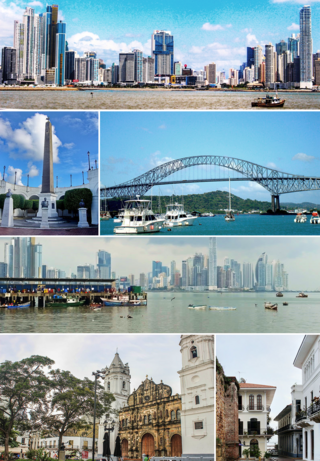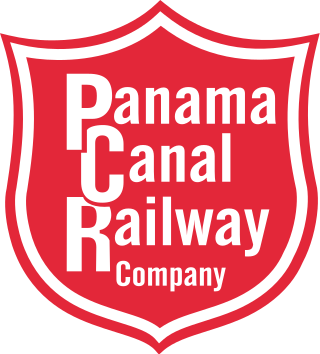
Central America is a subregion of the Americas. Its political boundaries are defined as bordering Mexico to the north, Colombia to the south, the Caribbean Sea to the east, and the Pacific Ocean to the west. Central America usually consists of seven countries: Belize, Costa Rica, El Salvador, Guatemala, Honduras, Nicaragua, and Panama. Within Central America is the Mesoamerican biodiversity hotspot, which extends from northern Guatemala to central Panama. Due to the presence of several active geologic faults and the Central America Volcanic Arc, there is a high amount of seismic activity in the region, such as volcanic eruptions and earthquakes which has resulted in death, injury, and property damage.

Panama, officially the Republic of Panama, is a transcontinental country in Central America, spanning the southern tip of North America into the northern part of South America. It is bordered by Costa Rica to the west, Colombia to the southeast, the Caribbean Sea to the north, and the Pacific Ocean to the south. Its capital and largest city is Panama City, whose metropolitan area is home to nearly half the country's over 4 million inhabitants.

The Panama Canal is an artificial 82 km (51 mi) waterway in Panama that connects the Atlantic Ocean with the Pacific Ocean and divides North and South America. The canal cuts across the Isthmus of Panama and is a conduit for maritime trade. One of the largest and most difficult engineering projects ever undertaken, the Panama Canal shortcut greatly reduces the time for ships to travel between the Atlantic and Pacific oceans, enabling them to avoid the lengthy, hazardous Cape Horn route around the southernmost tip of South America via the Drake Passage or Strait of Magellan.

Panama City, also known as Panama, is the capital and largest city of Panama. It has a total population of 1,938,000, with over 1,500,000 in its urban area. The city is located at the Pacific entrance of the Panama Canal, in the province of Panama. The city is the political and administrative center of the country, as well as a hub for banking and commerce.

Manuel Antonio Noriega Moreno was a Panamanian dictator, politician and military officer who was the de facto ruler of Panama from 1983 to 1989. An authoritarian ruler who amassed a personal fortune through drug trafficking operations, he had longstanding ties to United States intelligence agencies before the U.S. invasion of Panama removed him from power.

Panama City is a city in and the county seat of Bay County, Florida, United States. Located along U.S. Highway 98 (US 98), it is the largest city between Tallahassee and Pensacola. It is also the most populated city of the Panama City–Lynn Haven, Florida metropolitan statistical area. Panama City was severely damaged when Hurricane Michael made landfall as a Category 5 hurricane on October 10, 2018. As of the 2020 census, the population was 35,392, down from the figure of 36,484 at the 2010 census.

Panama City Beach is a resort town in Bay County, Florida, United States, on the Gulf of Mexico coast. It had a population of 12,018 in 2010. The city is often referred to under the umbrella term of "Panama City". Panama City Beach's slogan is "The World's Most Beautiful Beaches" due to the unique, sugar-white sandy beaches of northwest Florida.

The United States invasion of Panama, codenamed Operation Just Cause, began in mid-December 1989 during the presidency of George H. W. Bush. The primary purpose of the invasion was to depose the de facto ruler of Panama, General Manuel Noriega, who was wanted by U.S. authorities for racketeering and drug trafficking. The operation concluded in late January 1990 with the surrender of Noriega. The Panama Defense Forces (PDF) were dissolved, and President-elect Guillermo Endara was sworn into office.

The Panama Canal Zone, also simply known as the Canal Zone, was an unincorporated territory of the United States, located in the Isthmus of Panama, that existed from 1903 to 1979. It was located within the territory of Panama, consisting of the Panama Canal and an area generally extending five miles (8 km) on each side of the centerline, but excluding Panama City and Colón. Its capital was Balboa.

Rubén Blades Bellido de Luna, known professionally as Rubén Blades, is a Panamanian musician, singer, composer, actor, activist, and politician, performing musically most often in the salsa, and Latin jazz genres. As a songwriter, Blades brought the lyrical sophistication of Central American nueva canción and Cuban nueva trova as well as experimental tempos and politically inspired Son Cubano salsa to his music, creating "thinking persons' (salsa) dance music". Blades has written dozens of hit songs, including "Pedro Navaja" and "El Cantante". He has won eleven Grammy Awards out of seventeen nominations and eleven Latin Grammy Awards.

The Panama Canal Railway is a railway line linking the Atlantic Ocean to the Pacific Ocean in Central America. The route stretches 47.6 miles (76.6 km) across the Isthmus of Panama from Colón (Atlantic) to Balboa. Because of the difficult physical conditions of the route and state of technology, the construction was renowned as an international engineering achievement, one that cost US$8 million and the lives of an estimated 5,000 to 10,000 workers. Opened in 1855, the railway preceded the Panama Canal by half a century; the railway was vital in assisting the construction of the canal in the early 1900s. With the opening of the canal, the railroad's route was changed as a result of the creation of Gatun Lake, which flooded part of the original route. Following World War II, the railroad's importance declined and much of it fell into a state of neglect until 1998, when a project to rebuild the railroad to haul intermodal traffic began; the new railroad opened in 2001.

A Panama hat, also known as an Ecuadorian hat, a jipijapa hat, or a toquilla straw hat, is a traditional brimmed straw hat of Ecuadorian origin. Traditionally, hats were made from the plaited leaves of the Carludovica palmata plant, known locally as the toquilla palm or jipijapa palm, although it is a palm-like plant rather than a true palm.

The Señorita Panamá is a national beauty pageant in Panama. As of the 2023 edition, Miss Panamá winners represent Panamá in Miss Universe and the Señorita Panamá winners represent Panama in Miss International. The Miss Panama brand started in 1952, when the Panamanian Institute of Tourism received an invitation from Miss Universe to send a representative. In 1975, the Señorita Panamá name was used for the first time, reverting to Miss Panama in 1976. In 1982, Señorita Panamá was created by RPC Channel 4 as an alternative to send its winners to the Miss World contest in London. These pageants, along with smaller pageants such as Miss International Panamá and Miss World Panamá celebrated to select delegates for international representations.

Panama and the United States cooperate in promoting economic, political, security, and social development through international agencies.

Naval Support Activity Panama City, is a military shore installation of the United States Navy located in Bay County, in Panama City, Florida. Among its various tenant commands, it houses the Naval Surface Warfare Center Panama City Division, the Center for Explosive Ordnance Disposal & Diving (CENEODDIVE), the Navy Experimental Diving Unit (NEDU), and Coast Guard Station Panama City.

Panamanians are people identified with Panama, a country in Central America and with residential, legal, historical, or cultural connections with North America. For most Panamanians, several or all of these connections exist and are collectively the source of their Panamanian identity. Panama is a multilingual and multicultural society, home to people of many different ethnicities and religions. Therefore, many Panamanians do not equate their nationality with ethnicity, but with citizenship and allegiance to Panama. The overwhelming majority of Panamanians are the product of varying degrees of admixture between European ethnic groups with native Amerindians who are indigenous to Panama's modern territory.

The Panama Papers are 11.5 million leaked documents that were published beginning on April 3, 2016. The papers detail financial and attorney–client information for more than 214,488 offshore entities. The documents, some dating back to the 1970s, were created by, and taken from, former Panamanian offshore law firm and corporate service provider Mossack Fonseca, and compiled with similar leaks into a searchable database.

The COVID-19 pandemic in Panama was a part of the worldwide pandemic of the coronavirus disease caused by severe acute respiratory syndrome coronavirus 2. The virus was confirmed to have spread to Panama on 9 March 2020. One of the dead was a 64-year-old male, who also had diabetes and pneumonia. Of those infected, 83 were hospitalized. The infected individuals belonged to the 29-59 age group and had each recently travelled abroad. A 13-year-old girl died of COVID-19 on 23 March 2020.
Anarchism in Panama began as an organized movement among immigrant workers, brought to the country to work on the numerous megaprojects throughout its history.
















